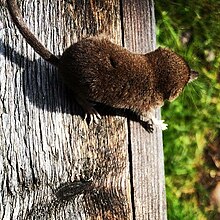Species of mammal
| Laxmann's shrew[1] |
 |
| Specimen with typical white feet (the brush tail is not shown) |
Conservation status |
 Least Concern (IUCN 3.1)[2] |
Scientific classification  |
| Domain: | Eukaryota |
| Kingdom: | Animalia |
| Phylum: | Chordata |
| Class: | Mammalia |
| Order: | Eulipotyphla |
| Family: | Soricidae |
| Genus: | Sorex |
| Species: | S. caecutiens |
| Binomial name |
Sorex caecutiens
Laxmann, 1788 |
 |
| Laxmann's shrew range |
Laxmann's shrew (Sorex caecutiens), or the masked shrew,[2] is a species of shrew.[1] Its range extends from northern Scandinavia and the Baltic to the Sea of Japan, including Hokkaidō, Sakhalin, and the Korean Peninsula. It favours mountain forests but is sometimes found in tundra and moorland, and also in lowland areas as well. It avoids cultivated land.
Taxonomy
This shrew was first described in 1788 by the Finnish-Swedish explorer and naturalist Erik Laxmann, who called it Sorex caecutiens, and it is commonly known as Laxmann's shrew. The type locality is to the southwest of Lake Baikal in Russia. Several subspecies are recognised, including S. c. hallamontanus from Jeju Island in South Korea.[3]
Description
An adult Laxmann's shrew has a weight of 3 to 11 g (0.1 to 0.4 oz) and a head-and-body length of 4.8 to 7.8 cm (1.9 to 3.1 in), with a tail of 3.9 to 5.2 cm (1.5 to 2.0 in).[4] The snout is long and narrow and lacks a pale coloured streak at the side. The teeth have red tips, and the dentition distinguishes this shrew from other similar species. The fur is shiny, the pelage is bicoloured, and the feet are white. The tail is always more than half the head-and-body length, and is usually more than 65%; the tail has no long hairs except for a tuft at the tip.[3][5]
Distribution and habitat
Laxmann's shrew is found in the taiga zone of northern Europe and Asia. Its range extends from Norway and Sweden through northern Siberia to northwestern and northeastern China, Korea, Japan, and Sakhalin Island. It is widely distributed in both mountain and lowland forests, and also in the adjoining tundra. It favours damp woodland with plenty of moss, bushy scrub, and small trees, and the banks of streams and borders of swamps on moorland. It is not found on cultivated land.[2][5]
Ecology
This species is mainly diurnal and feeds on small invertebrates such as insects (especially beetles), spiders, millipedes, and earthworms, as well as conifer seeds when available. Breeding takes place in the summer when up to four litters of 2 to 11 (usually 7 or 8) young are born in an underground nest. Longevity is probably about one year.[3]
Status
S. caecutiens has an extremely wide distribution and is described as being abundant in many parts of its range. Other than the felling of timber, no particular threats have been identified, the total population size seems to be steady and the International Union for Conservation of Nature has rated its conservation status as being of "least concern".[2]
See also
References
- ^ a b Hutterer, R. (2005). Wilson, D.E.; Reeder, D.M. (eds.). Mammal Species of the World: A Taxonomic and Geographic Reference (3rd ed.). Johns Hopkins University Press. pp. 285–286. ISBN 978-0-8018-8221-0. OCLC 62265494.
- ^ a b c d Henttonen, H.; Sheftel, B.; Ariunbold, J. (2016). "Sorex caecutiens". IUCN Red List of Threatened Species. 2016: e.T29662A22314809. doi:10.2305/IUCN.UK.2016-2.RLTS.T29662A22314809.en. Retrieved 19 November 2021.
- ^ a b c Jo, Yeong-Seok; Baccus, John T.; Koprowski, John L. (2018). Mammals of Korea. National Institute of Biological Resources. pp. 88–90. ISBN 978-89-6811-369-7.
- ^ Won, Byeong-o (원병오) (2004). 한국의 포유동물 (Hangugui poyudongmul, Mammals of Korea). Seoul: Dongbang Media. ISBN 89-8457-310-8.
- ^ a b Smith, Andrew T.; Xie, Yan (2013). Mammals of China. Princeton University Press. pp. 204–205. ISBN 978-1-4008-4688-7.
Taxon identifiers |
|---|
| Sorex caecutiens | |
|---|













